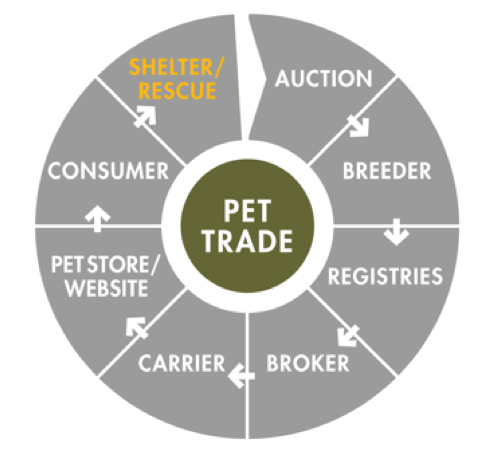| |

issue
|
|
issue > puppy/kitten mills > pet trade industry
KEY MESSAGE: In the United States, the pet trade industry generates billions of dollars due to a sophisticated distribution system, profiting many players. Breeders and dealers are a subset of this industry, producing and providing the "living products."

A multi-billion dollar industry
It's estimated that pet trade industry is a multi-billion dollar industry. As with other industries, it depends on a full system of distribution that crosses state borders, which is why it’s defined in terms of commerce.
Breeders are only one part of the ‘commerce’ picture.
- AUCTION: Many of the stud males and intact females, as well as other dogs, cats, puppies and kittens, are bought and sold through organized auctions. NOTE: Minnesota has not been known for auctions that sell dogs and cats, but there are rural auctions where some animals and displayed and sold along with farm equipment, flowers and other items. Winona County is known for holding an auction that sells dogs and puppies (multiple breeders are located in that area.)
- BREEDER: Commercial breeders produce the puppies or kittens, keeping a few or hundreds of adult intact animals in their kennels. Size and conditions vary. As this is 'business (for profit),' key goal is to generate sales and income.
- REGISTRIES: Registry companies register the animals for pedigreed, giving a ‘stamp of approval.' Registry fees generate money. These registry papers have been known to be falsified, misleading consumers.
- BROKERS: Brokers (small businesses and large corporations) buy the puppies and kittens to sell to pet stores, dealers or other companies. Brokers are also referred to as dealers, or 'the middle-man.'
- CARRIERS: Carrier companies transport the animals within and across State lines or to other countries. Often, breeders and brokers may drive a truck themselves with the puppies on board. This involved interstate commerce.
- PET STORES/WEBSITES: Pet stores, the Internet and local newspapers (through classifieds) advertise the animals for sale, and generate profit from each sale.
- CONSUMERS: Consumers buy. Often consumers are not aware of where the puppy or kitten was born or the condition of the adult dogs/cats or kennels.
- SHELTERS/RESCUES: If the dog or cat is no longer wanted or abandoned by the consumer (or by breeders), animal shelters and rescue organizations assume the care, treatment, housing and e-homing of the animal — with no financial assistance from the pet trade industry.
- NOTE: Veterinarians are also a part of this network. Licensed breeders and brokers are required to hire ‘attending veterinarians’ to examine the animals, monitor their health, and prepare the veterinary care plan. Veterinarians are also required to examine the animal prior to transport (to check for infectious, contagious or communicable disease) and prior to selling (see Pet Lemon Law). As in any industry, the values, beliefs and skills of each veterinarian varies — some work with large-scale commercial breeders because it's income and they support the industry; some work only with small-scale breeders; others work with animal rescues and shelters and did not support the production industry.
Supporting link: Damaged dogs plucked from assembly line
A growing industry
According to the 2019-2020 APPA National Pet Owners Survey, 67% of U.S. households own a pet, which equates to 84.9 million homes. In 1998, the first year the survey was conducted, 56% of U.S. households owned a pet. Contrast this to the U.S. Census which states that about 33% of Americans have kids (under 18 years of age) living at home. In other words, more homes have pets than kids.
It’s estimated there 63.4 million households own a dog and 42.7 million households own a cat in the United States (per APPA).
Other pet ownership facts:
- In 2020, it is estimated that $99 billion will be spent per year on pets by Americans ; in 2012, actual expenditures was $53.33 billion and in 1994, $17 billion. (Source: APPA Survey).
- Per APPA 2019-2020 survey: Basic annual expenses for dog and cat owners include: $426 (for dogs) and $214 (for cats) for surgical vet visits; $212 (for dogs) and $160 (for cats) for routine vet visits; $259 (for dogs) and $228 (for cats) for food. (Source: APPA Survey).
- $195 was spent by Americans for pet insurance in 2007; a 21% increase from 2006 (Source: Small Business Trends)
- PetSmart shifted its mission from being “the top seller of pet food to helping consumers become better pet parents.” (Source: The Pet Economy)
Americans love their pets. When the public buys, however, they’re often not aware of how and where these animals are being ‘produced’.
|
|

